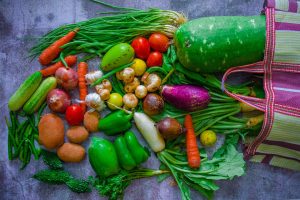By Lee Van Ham
Do you absolutely have to buy the cheapest food for your budget? Okay, if your budget allows nothing else. Do you absolutely have to buy where food is most convenient? Okay, if you must. Just be aware that convenience betrays Earth again and again.
 So, if you can, by all means, buy healthy food. Why? Because you buy so much more than food. You buy into a way of farming that sustains life—OneEarth agriculture. You buy healthy soils. You resist and harm factory farms. You reduce Big Ag pollution which contributes one-third of greenhouse gases to the atmosphere. You empower small farmers who take better care of Mother Earth. By paying a little more for our food gives us a much bigger bang for our buck?
So, if you can, by all means, buy healthy food. Why? Because you buy so much more than food. You buy into a way of farming that sustains life—OneEarth agriculture. You buy healthy soils. You resist and harm factory farms. You reduce Big Ag pollution which contributes one-third of greenhouse gases to the atmosphere. You empower small farmers who take better care of Mother Earth. By paying a little more for our food gives us a much bigger bang for our buck?
Let’s look at some of what we’re buying in more detail.
The Health of Soils— Current industrial farming pours excessive chemicals into soils to maximize yield and profits. But these same chemicals have killed millions of microbes in the soils. These soils are soon dead and can grow plants only by using more chemicals—more profit for Big Ag companies. Resistance to pests is reduced, so pesticides need to be poured onto the fields—more profit for Big Ag companies. The runoff of chemical fertilizers and pesticides via erosion from these fields contaminates rivers and creates dead zones in the Gulf of Mexico—costs Big Ag companies never pay for but taxpayers do.
By contrast, small regenerative farms use organic methods that regenerate microbes and trace minerals in soils. Instead of chemicals to enrich soils and control pests, Nature’s way is followed with composting, manure, crop rotation, and planting diverse crops on acres, creating biodiversity instead of monocultures.
Buying healthy, organic, local foods also buys healthy soils and cuts into Big Ag profits.
How Land Gets Used — Current industrial farming plants millions of acres of grain in large mono-cropped tracts of land. Take corn as an example. Almost all of it is mono-cropped and generates food not at all or inefficiently. On average in the U.S., about 45 percent of corn is used for animal feed which becomes human food inefficiently and at high costs environmentally. Ethanol uses 44 percent of a corn crop. Only 10 percent goes directly into food, but about one-third of it is converted into high-fructose corn syrup—an unhealthy sweetener. Considering all crops, more than 67 percent of crops — particularly all the soy grown in the Midwest — goes to animal feed.
By contrast, small produce farmers use land in a way that maximizes calories per square foot. Consider that beef is a big user of acres when all the land used to grow feed is added to the feedlot footprint. Furthermore, overwhelming evidence shows that overconsumption of beef and other meat is bad for human health and environmental health as well. When we move towards a more plant-based diet we take action for a more sustainable environment. If in the U.S., beef were replaced by beans, 42% of U.S. cropland could be freed up, and greenhouse gas emissions would be reduced to where it alone would accomplish 75% of the 2020 carbon reduction target.
Buying healthy, organic, local foods also buys into OneEarth uses of land and cuts into Big Ag profits.
How Water Is Used —The crescendoing ecological crises underway mean water is increasingly scarce in many food-growing regions. Lifestyle changes along with policy revisions are required. Lowering meat in what we eat impacts water in big ways. Consider that 1/3-pound hamburger requires 680 gallons of water. Most of this water is for producing beef which includes irrigation of the grains and grasses in feed, plus water for drinking and processing. By contrast, the water footprint of a Beyond Meat Burger is 1.13 gallons per burger. That’s 58 times lower than a beef burger.
Buying healthy, organic, local foods also buys into OneEarth use of water and cuts into Big Ag profits.
What we pay at the checkout counter is not the full cost of our food nor the full explanation of what we are buying. Every check-out contributes to MultiEarth systems that make profits top priority OR to OneEarth systems that make people and life top priority.
Photo by Ratul Ghosh on Unsplash





